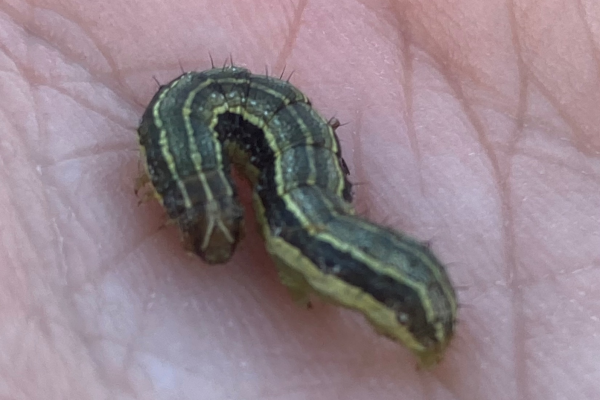
Armyworms Infesting the Carolinas
Armyworms appear in large numbers in the early morning and late evening, ready to consume turfgrass, garden plants, corn-strain crops, and many other grass species. They are voracious caterpillars that eventually develop into less destructive moths. However, the damage caused by armyworms is challenging to repair and sometimes irreversible.
Why is the Armyworm Infestation in the Carolinas So Bad This Year?
The Carolinas have experienced an abnormally wet, humid late summer in 2024. Armyworms and other pests thrive in climates where heavy rains and temperatures in the 90s promote lush grass and crop growth. With plenty to eat and few predators, armyworms invade lawns and gardens in the dark like a large battalion of soldiers marching onto a battlefield.
According to Entomologists, the Armyworm infestation in the Carolinas is happening because they overwintered as pupae in Florida. Once the pupae emerged as moths, the moths migrated north over the spring and summer. Each moth likely laid as many as 1000 eggs throughout North and South Carolina in late summer. Within several days, the eggs hatched into millions of armyworms with insatiable appetites.
Identifying the Armyworm
Armyworms vary in color and can be black, brown, or green. They range from one to one-and-a-half inches long and have a distinct black stripe extending down both sides of their bodies. The most distinguishing featured of armyworm caterpillars is a yellow to whiteish upside-down “Y” shape on their head. In addition, the armyworm’s head is slightly darker than its strip colors.
Armyworms do not bite or sting humans when picked up and do not carry diseases that can be transmitted to animals or humans.
Signs of an Armyworm Infestations: When to Call an Armyworm Exterminator
Look for armyworms before the sun rises and after sunset. Although they sporadically feed during the day, they emerge in vast numbers at night to stampede through lawns, gardens, and crops, leaving behind brown patches of dead grass, ravaged foliage, and destroyed crops. Another way you can tell if your lawn has armyworms is to mix one to two tablespoons of lemon-scented dish detergent in two gallons of water and mix thoroughly. Then, very slowly, pour these two gallons over a one square yard section of healthy lawn next to a damaged area. Armyworms, if present, should emerge within 10 minutes of application.
Other signs you need professional armyworm control include:
- Chewed, torn leaf edges on plants
- An increase in bird activity around suspected areas of armyworm infestations
- Bare spots in your yard, where you can see the soil
- Armyworm droppings (tiny greenish pellets) lying around plants and grass
- Pulling clumps of grass without tugging (weakened roots)
Getting Rid of Armyworms Can Be a Hassle
Getting rid of armyworms is not a DIY project as the safe application of a properly labeled insecticide is most likely needed. You can purchase a species of wasp called Trichogramma and release them on your property to parasitize and kill armyworm eggs. However, this method doesn’t guarantee that all eggs will be destroyed.
Call Clark’s Termite & Pest Control today for prompt armyworm exterminator services. We have the industry-specific treatments and equipment necessary for comprehensive armyworm control to prevent extensive damage to your garden, lawn, and property foliage.
Don’t wait until you see signs of an armyworm infestation. Schedule an appointment today for a Clark’s Termite & Pest Control specialist to inspect your property and begin treatment to stop armyworm battalions before they attack.
